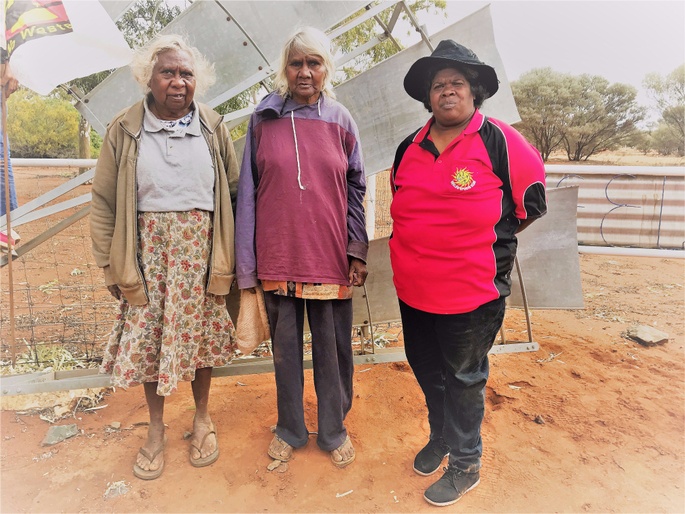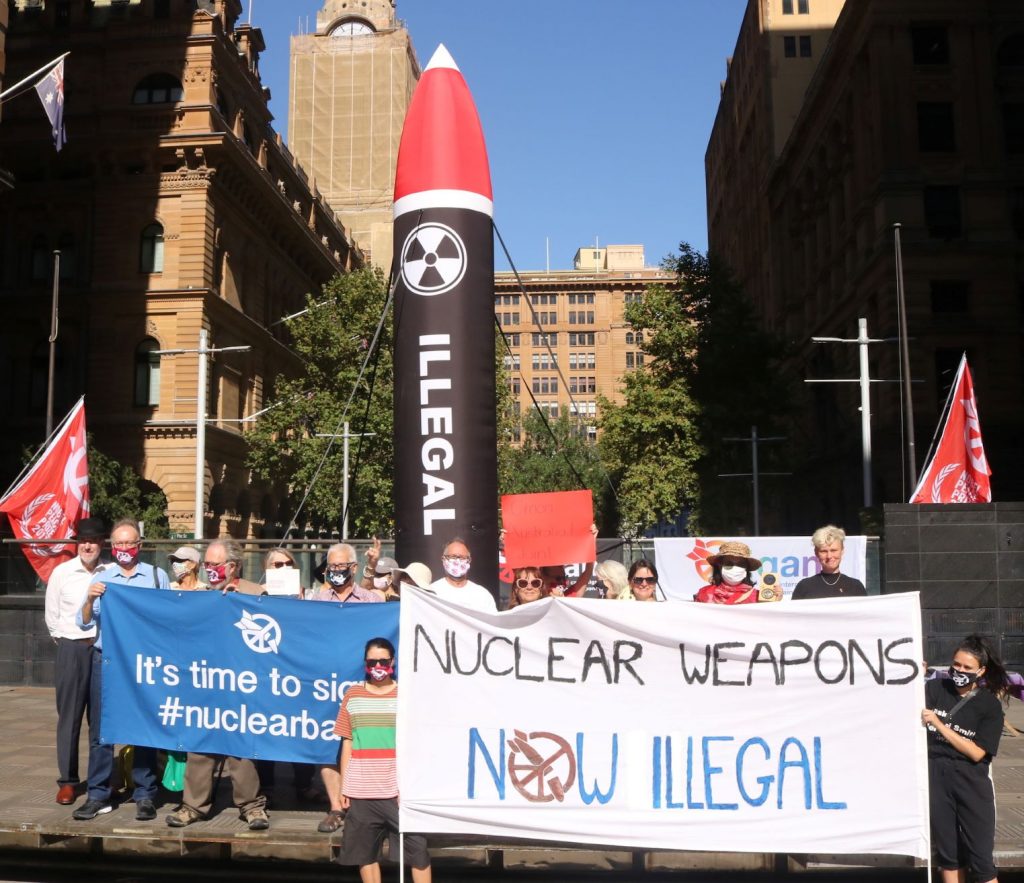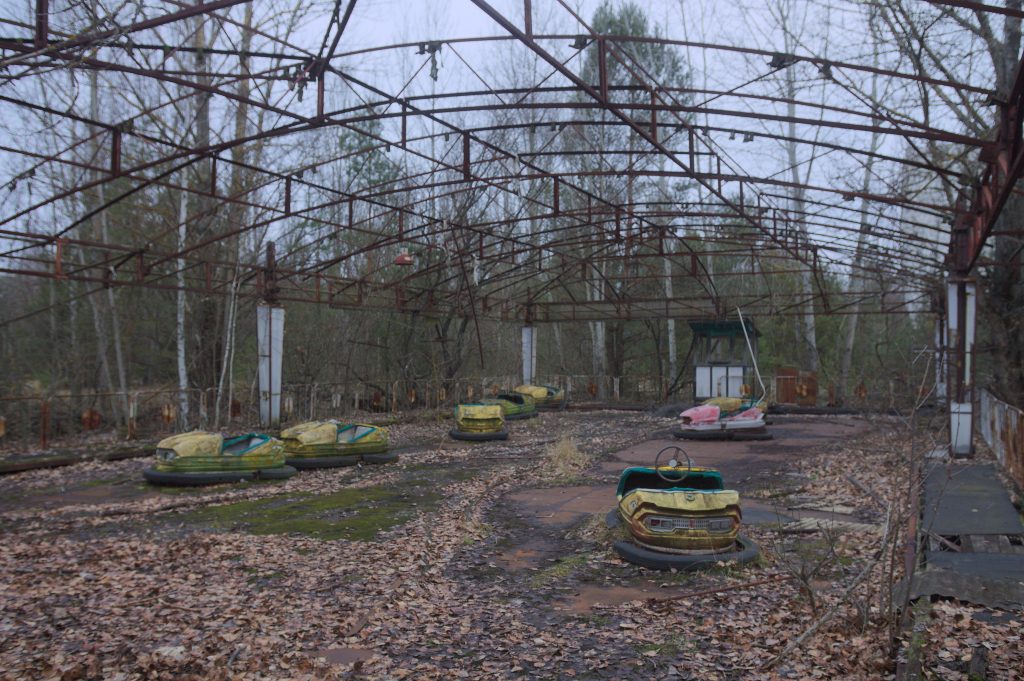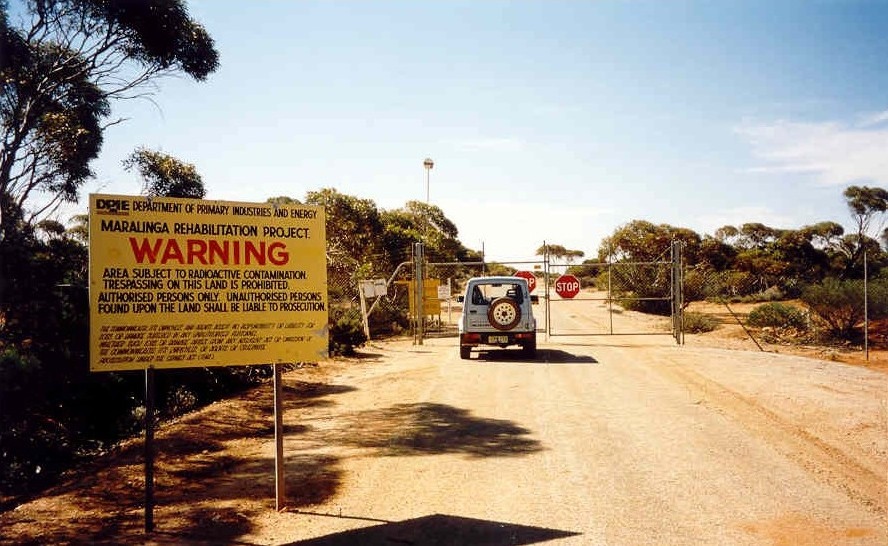By Kerry Laws
For many years those involved in Australia's anti-uranium movement have been in awe of three courageous Tjiwarl women, Shirley & Elizabeth Wonyabong and Vicki Abdullah. Their determination and persistence to protect their ancestral country, on the edge of the Western Australian goldfields, from uranium mining has been an inspiration.
Receiving a National Environment Award from the Australian Conservation Fund in 2019 gave them a glimmer of recognition but little mainstream media attention, despite having persevered in their resistance to a mine for almost 50 years.
Their Country forms part of the Seven Sisters' songline at Yeelirrie, 700kms north of Perth, and their tireless but tumultuous struggle has taken place both through innovative protest actions on Country and through a protracted court case which was highlighted in a recent ABC 7.30 report.

After having been such a hot topic through the 70s and 80s, uranium mining is rarely under the spotlight these days, and many Australians have little idea about the current state of play.
The Mining of Uranium
While Australia remains the third-largest exporter of uranium globally, there are only two uranium mines currently operating: Olympic Dam and Beverley Four Mile in South Australia. Other mines are targeted for South and Western Australia, including the Yeelirrie mine on Tjiwarl Country, but the drop in the price of uranium since the Fukushima disaster of 2011 remains a major disincentive to the development or expansion of uranium mining. However these situations are fluid and the industry itself is forever spruiking uranium's imminent recovery and ‘expected’ price rise.
Even if things are slow right now, what the 7.30 report revealed was that while our governments are at the behest of the mining industry, we need to be alert to the weakness of our current environment and cultural protection laws.
The investigations broadcast by the ABC revealed how easily the Canadian company Cameco was able to influence the formal process at both state and federal levels in its haste to gain approval for the Yeelirrie mine. Both the government and the company knew of the studies showing that the clearing of 2,400 hectares for its proposed ten square kilometre open-cut mine would bring about the extinction of several species.

One of these species is the recently discovered Stygofauna, tiny 'living fossils' that had adapted to subterranean life around the aquifers under the forest over millions of years and are known to exist nowhere else on the planet.
Despite or because of this knowledge, Cameco pushed the WA state government to drop the requirement that it "demonstrate no species could be made extinct by the mine" and managed to have the minister give its approval in 2017. At this stage the Federal Government was still opposed to the mine. Yet, as the possibility of a change of government loomed, Cameco lobbied federal Resources Minister, Matt Canavan, to intervene.
At the 11th hour the Federal Minister for the Environment, Melissa Price, did a complete turnaround giving her approval to the mine the night before the federal election was announced in January 2019. According to Dave Sweeney from the Australian Conservation Foundation, Price signed off on it within hours of receiving the late-night submission, consisting of 600 plus pages of detailed documentation. In Sweeney's words the process was "dodgy from the get-go".
With the support of the Conservation Council of WA, the three Tjiwarl custodians challenged the questionable process of approval in the Supreme Court in a landmark hearing which they ultimately lost.
The Traditional Owners have since been fenced off from access to their Country, even though it is unlikely that mining will commence while prices continue to languish. Shirley Wonyabong describes the pain saying "It feels like we lost our spirit inside of us".
The Issues around Uranium Mines are Multi-Layered
Uranium mining shares many issues common to all mining - the loss of connection to Country for our First Nations People for ceremony, cultural learning and conservation, the inevitable clearing of significant forest and habitat, irreparable damage to biodiversity and the diversion of extreme quantities of water.
Other aspects such as radioactive emissions that poison miners and surrounding country and waterways or potentially contribute to nuclear accidents or weaponry are particular to uranium and rare earth mining and leave a toxic legacy for thousands of years.
To date rehabilitation of mines simply does not happen. Associate Professor Gavin Mudd, Chair of the Mineral Policy Institute, says that in over 24 years of research and investigation into our many depleted mining sites he has not seen a single case of successful rehabilitation.
The former Mary Kathleen mine, for example, won a national award for excellence for the work completed there in 1986. But by the late 90s it was found to have acid seepage leading to high levels of heavy metal content in surrounding grasslands. Moreover, the costs of rehabilitation can far outweigh the value accrued from the actual mine. Addressing the acidic and radioactive leaks from the Rum Jungle mine, which resulted in a biologically dead Finniss River, cost Australian taxpayers A$875 million for a return of A$139 million.
Nuclear Power
Given the combination of risks and costs, with dwindling economic return, you would think that it would be game-over for the uranium industry. Instead, mining companies continue to circle our reserves. Almost every year we have politicians throwing up the idea that we should increase production and take it to the next stage with our own nuclear power stations for energy generation.
Calls to remember Chernobyl or Fukushima are waved aside with arguments that the next-generation reactors are more efficient and foolproof. Not much of an assurance considering that nearly all accidents to date can be attributed to corporate management greed in cutting costs and disregarding safety measures, or to simple human error.
Every so often our own beautiful Jervis Bay is flaunted as a suitable reactor site, a chilling thought when the far-reaching devastation of Fukushima is still so fresh in our minds.
Fortunately for us, the reality is that construction of any new plant would take over 20 years and even the most stubborn uranium supporter can see the foolhardiness in such long-range projects. Relying on current technology and costing to projects so far into the future is dangerous when rapid energy production change is inevitable.
Contrary to the arguments frequently peddled, nuclear power is not carbon free. Nuclear power generation releases twice as much carbon as solar and ten times as much as offshore wind farms. Every aspect of the nuclear chain contributes to carbon emissions: the uranium mining itself, transportation and processing, plant construction, operation and decommissioning, and long-term waste management.
Radioactive Waste Management
While new mines and reactors are mostly on the back burner, radioactive waste and how we deal with it are the most crucial issues for Australia right now. Federal governments have been seeking a solution to this for the past 29 years to no avail. With astonishing repetition they attempt to impose a waste facility on unwilling First Nations' communities, all with the promise of sweeteners and benefits that should already be available to all Australians.
Not only have these failed ad hoc attempts cost the government time and money but they have also brought great stress, hardship and division to those communities who have had to put their lives on hold while they mobilise against the government's increasingly desperate efforts.
Ngapa and other clans fought for eight years to resist having a waste facility sited on their land at Muckaty Station in the NT before winning their case in 2014.
Subsequently, with no community consultation, nominations were taken from landowners across Australia and a short-list of six sites announced. This left six communities scrabbling to find out what this would mean for them. Land owned by a former LNP senator was selected, a decision challenged by the Adnyamathanha Traditional Owners who pointed out the unsuitability of the culturally rich but seismically unstable property in the Flinders Ranges.
The battleground has now moved to the prime farming area near Kimba in SA, where it is reportedly opposed by 70 per cent of the population and 100 per cent of the Barngala traditional owners who were initially sidelined and deprived of a vote.
This week Resource Minister Keith Pitt's bill proposing the site was rejected by the Senate suggesting the selection process is far from over.
Meanwhile the majority of Australia's nuclear waste is currently stored at the Australian Nuclear Science and Technology Organisation (ANSTO) facility at Lucas Heights on the outskirts of Sydney. This would seem to be the most appropriate place since it is safe and secure with expertise at hand, close monitoring, 24-hour police guard, and avoids unnecessary multi-handling and transportation, along with the increased risk of theft and accidents that a more remote location would bring. There is capacity for it to be stored at Lucas Heights for several decades, allowing time for a more scientifically based solution to be reached.
Reducing the Waste
The most common argument for pushing waste onto unsuspecting communities is that we all benefit from nuclear medicine and must therefore bear the responsibility of waste. Dr Margaret Beavis, a practising GP who lectures in both medicine and nuclear waste at Melbourne University, dispels this myth.
She points out that nuclear medicine will continue regardless of the establishment (or not) of an alternative waste facility, and that the amount and radioactivity of the waste produced could be severely reduced by adopting alternative technologies.
Radioactive waste is produced not so much through the use of medical isotopes as through their production. There are alternative technologies now available for producing the medical isotopes required for nuclear medicine that halve the amount of waste produced.
For this reason Canada, the US and the UK are all moving towards producing isotopes through accelerators or cyclotrons instead of reactors. We could also take this route but instead have opted to ramp up our use of the reactor to produce isotopes for export, leaving the Australian community to deal with the excessive waste produced.
Even more concerning is that while the use of most medical isotopes only produces short-lived waste that can be safely discarded after several months, the production of the isotopes through a reactor produces long-lived intermediate level waste (ILW) that lasts for 100,000 years.
ANSTO's business plan, to increase the production of isotopes for export, was pushed through with no community consultation, debate or consensus. From the point of view of waste management and safety, the use of the reactor for this purpose should be discontinued as soon as possible and the production of medical isotopes decentralised through other means.
The Biggest Threat of All – Weapons Testing and Proliferation
As we can see, so many aspects of the nuclear chain are based on questionable ethics and even dodgier practises. The tragic historic double bombing in Japan in 1945 gave the world an inkling of the atom bomb's capability and its ability to devastate cities and end lives in a most tortuous way. Instead of acting as a deterrent, it set many countries on the deathly pathway of building nuclear capability.
Australia played its part. Menzies offered up three different sites to the British Government for weapons testing, at Montebello in WA and Emu Plains and Maralinga in SA where most of the testing took place.
Little concern was shown for the lives or health of the thousands of Anangu Pitjantjatjara people living around the Maralinga site. One person was allocated to drive around warning them and even he was disciplined by the Chief Scientist for seeming to "place the affairs of a handful of natives above those of the British Commonwealth of Nations". (The ABC drama Operation Buffalo also gives an idea of the prevailing attitudes at the time and is available on iView.)
It will never be known how many died directly as a result of the tests that were carried out between 1952 and 1963, but for the descendants of the area and for the veterans involved, high rates of cancer and fertility issues continue today.
Radioactive fallout was detected as far away as Townsville but the most severe local contamination was from the dispersal of plutonium, which has a half-life of 24,000 years. Over $100 million was spent on decontamination and the traditional owners were not handed back their land until 2009.
Even the original plans by Prime Minister Gorton in 1969 for a nuclear power reactor at Jervis Bay were likely motivated by a well-documented desire to enter into nuclear weapons capability, though this was not publicly acknowledged at the time. As it turned out, Gorton's successor PM William McMahon was more conscious of the massive costs involved. The plans were put to rest and eventually shelved.
At the same time however, the US began constructing nuclear military bases in Australia, leading to a decline in support for our own weapons capability while building the belief in the protection of the 'nuclear umbrella' of the US.
The idea of there being safety in nuclear deterrence has brought us to the precipice we now face. The nine nuclear nations of the world have stockpiled a total of 14,000 nuclear warheads, of which 92 per cent belong to the US and Russia. About 1800 warheads are on high alert, ready for use at short notice.
If even a small number of these were deployed, the earth would experience a nuclear winter effectively ending most life on the planet. Clearly there would be no winner. And when humans are in charge, human error and the possibility of accidental deployment is always on the cards.
ICAN and the UN Treaty on the Prohibition of Nuclear Weapons
In a bid to head off such a catastrophe, the International Campaign to Abolish Nuclear Weapons (ICAN) was launched in Melbourne in 2007. It soon became an international entity, gaining the support of the UN, the World Trade Union movement and the World Council of Churches.
In 2017, inspired by earlier campaigns to ban chemical and biological warfare, landmines and cluster bombs, a global majority of nations negotiated the UN Treaty on the Prohibition of Nuclear Weapons which was aligned to but went far beyond the existing Non-Proliferation Treaty. ICAN was awarded the Nobel Peace Prize in that same year for its role in achieving the treaty.
To enforce a treaty and make it a legal document at least 50 countries must sign up and ratify it. This was achieved in October 2020. The Treaty came into force 90 days later, just last month, on 22 January 2021. While it may not in the short term eliminate nuclear weapons, it stigmatises them, makes them illegal according to international law, and provides a pathway to disarmament.

Australia of course, beholden to the United States and the myth of protection, has neither signed nor ratified the treaty. The Department of Foreign Affairs outlines the reasons for opposing the Treaty in a single paragraph on its website. Its reasoning however is illogical and is based on several erroneous premises. ICAN addresses each of these very succinctly in the booklet For the Record: Addressing the Australian Government's misrepresentation of the UN Treaty on the Prohibition of Nuclear Weapons. Both the ALP and The Greens have committed to supporting the Treaty.
Uranium’s Legacy Filters Down to us All
The chilling historical consequences of Maralinga and the fictitious US protection umbrella are lethal and toxic legacies overshadowing every one of us living in Australia.
The Australian director of ICAN, Gem Romuld, is a resident of the Illawarra and has previously given a presentation on ICAN and the Treaty at Tomerong Hall. This is worth mentioning to underline the fact that while nuclear warfare and UN treaties are global matters that seem removed from our local communities, anyone of us can take action if we feel something is unacceptable. When enough people take action, change can be affected.
We also know that for those pushing nuclear power Jervis Bay is still in their sights.
Information and knowledge are powerful and we can't 'unknow' what we know. Uranium mining, nuclear power, ill-considered waste dumps and nuclear weaponry don't just sound dodgy, they are dodgy. We know the future is in the free and sustainable technologies of renewable solar, wind and water generated energy.
The nuclear chain contains many disasters in the making but we each have the choice whether to accept them or take action against them. What do you choose?
Has Kerry Laws’ article sparked your interest to know more? There are so many aspects to uranium mining - native title land, destruction of biodiversity, toxic waste disposal, weapons and war - and all are seriously important issues. Here are a few resources to get you started.
Find out how the Treaty works, see a copy of the Disarmament Treaty and who signed and ratified it to date, and what Entry-Into-Force means.
There is also information on why Australia should join the nuclear ban, and you can join the anti-nuclear campaign to stay up to date.
Watch the ABC’s 7:30 report Last minute environmental approval for a uranium mine called into question, or read about the shameful Maralinga project.
The World Nuclear Association monitors the international market and provides details on Australia's uranium mining industry. Friends of the Earth have a ton of information on uranium and nuclear and you can join their Nuclear-Free campaign.
If you agree nuclear weapons sound dodgy and need to be abolished you can:
- sign the petition calling on our elected representatives to make Australia nuclear-free which includes ratifying the nuclear weapons ban treaty
- write to your federal parliamentary representatives to tell them that the Treaty on the Prohibition of Nuclear Weapons is now in force. The time is right for Australia to do its part by signing and ratifying the ban.
- join the ICAN campaign.
Kerry Laws is a former language teacher and teacher educator and a founding member of Uranium Free NSW which was formed in 2012 after the NSW government overturned its 26-year moratorium on the exploration of uranium. Kerry is involved in a range of environmental and social justice groups, including the campaign to save the Husky Church and burial grounds, and is working at her fledgling art practice.
Feature image: Caution Radioactive Waste/flickr.com









Fabulous article. I feel so much more informed. Conscious, committed and concerned community members have so much to contribute to informing and inspiring others, there's and the greater community and having an independent paper and its volunteers willing to give them a voice is wonderful.
The vote in Kimba (After heavy Dept. of Industry propaganda and bribes extending over a number of years) gave 62% in favour of a NRWMF to be located in Kimba. Out of the 209 eligible Barngarla voters 83 responded and all voted No. They were deliberately excluded from the vote. The boundary for the vote was set as the Council area of Kimba. People in The Wudinna Council area living closer to the proposed site than some Kimba residents were (deliberately) excluded from the vote. The Federal (Liberal) member for Grey (Rowan Ramsey) (who is from Kimba) has pushed quite hard for this. It is well known that the Federal Resources minister (Keith Pitt) is a nuclear advocate, who has no shame in deliberately lying to the media. (For example he claimed on the Adelaide channel 7 news that stalling the NRWMF would result in a shortage of nuclear medicine which would result in un-necessary deaths). The NRWMF is again due for review in the Senate on Feb 17.
Great article Kerry and thank you for such a clear analysis of the impacts of reliance on uranium.